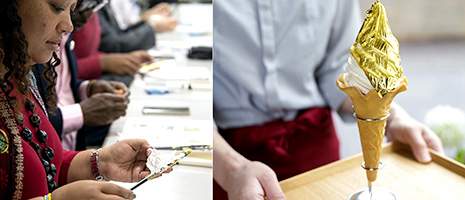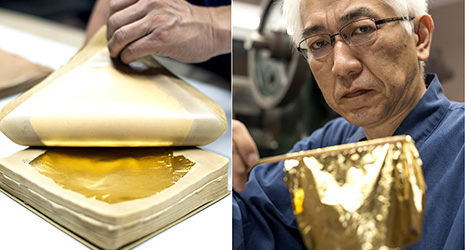Home > Highlighting JAPAN >Highlighting Japan April 2016>Traditional Crafts
Highlighting JAPAN


Striking Gold
Nowhere is the fine art of metal leaf production more refined than it is in Kanazawa, Ishikawa Prefecture. At Hakuichi, craftsmen use traditional techniques to make materials and products that continue to appeal to contemporary tastes.
The mechanical clank of machinery and rapid hammer-like thuds of metal on reinforced cardboard fill Tsutomu Yamane’s cramped workshop. After every few thumps of the haku-daki beating machine, which delivers each blow with a force of around one ton, Yamane deftly maneuvers the thick wad of papers, plugged ears dampening the back-beat to an inner rhythm he has rote-learned over thirty-six years.
As the machine stutters to a halt, Yamane unplugs his ears and peels back a page of film-like washi paper to reveal the fruit of his endeavors: a fluttering, glowing sheet of kinpaku, or gold leaf.
“Since olden times in Japan, gold leaf has been seen as a symbol of fortune and power,” says Yamane, 54, who began his career as a haku-uchi gold-beater straight out of high school. “For me making gold leaf requires patience. You have to work on it from scratch and to end up with such incredibly thin gold leaf gives me a real sense of satisfaction.”
As Yamane gently blows on a sheet of the leaf in order to lift it with a takebashi bamboo chopstick, that fragility is evident. At one-ten-thousandth of a millimeter (0.0001 mm), the kinpaku that he produces at gold and silver leaf specialist Hakuichi in Kanazawa, Ishikawa Prefecture, is around 1,000 times thinner than standard-use paper. Rub it between your fingers and it would disintegrate like a moth’s wing.
Getting it to that delicate, foil-like form requires a complex process that dates back centuries.
First, ingots of 24-carat gold along with small amounts of silver and bronze are melted at 1,300°C and passed through a rolling machine to stretch it into belt-like strips. These are cut into 6 cm squares, which are then beaten and cut up into quarters a further five times before reaching a state from which Yamane can work his magic.
Known as zumi, this leaf, already 0.0003 mm in thinness, is just one beating away from fine Kanazawa haku — the craftsmen’s shorthand term for gold leaf. Yamane says it is almost certainly this long accumulation of experience that allows him to create a product of such eye-catching beauty. And while the shimmering haku will send even the coolest customer all agog, Yamane says it is a far more humble item in that long learning curve that is the true star of the golden show.
“The washi paper, between which the zumi is placed, is absolutely crucial to the making of gold leaf,” says Yamane, who in 2015 was awarded the title of Dento Kogeishi, the highest designation bestowed on Japan’s traditional craftsmen. “It is so important, in fact, that it determines the quality of the leaf.”
The film-like paper is produced by adding egg white, persimmon tanin and other ingredients to the conventional washi-manufacturing process to create a durable paper that doesn’t break even when beaten.
Like washi making, gold leaf production has close associations with Buddhism and is thought to have been introduced to Japan along with Buddhism from China around 1,500 years ago. Kanazawa haku production, however, is thought to have started in 1593 by Toshiie Maeda, the first lord of the Kanazawa Domain, at the command of daimyo Hideyoshi Toyotomi. Maeda was said to be fond of sporting suits of armor decorated with gold leaf.
Today, Kanazawa produces around 99 percent of all Japan’s gold leaf, and can be found on much more than just suits of armor. Among the items incorporating gold leaf on display at Hakuichi are plates, fans, USB sticks and a range of cosmetics.
In keeping with the long-held belief in its health benefits, there are edible products as well. At Kanazawa’s Omicho Ichiba Market, you can find sashimi sprinkled with gold leaf, and soft serve ice cream entirely wrapped in gold leaf.
Hakuichi also gives visitors the opportunity to make crafts decorated with gold and silver leaf.
“In my country, people believe where there’s gold, there’s hope,” says Mohamed Bailley, 43, from Sierra Leone, as he applied leaf to a pair of chopsticks. “It signifies wealth and health, like in Japan, so I am happy to find this commonality.”
© 2009 Cabinet Office, Government of Japan






